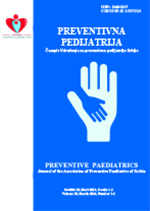HIGH-INTENSITY INTERVAL TRAINING IN THE TREATMANT OF OBESITY
DOI:
https://doi.org/10.46793/PP250220009SKeywords:
obesity, high-intensity interval training, HIIT, weight reduction, aerobic capacityAbstract
Introduction: High-intensity interval training (HIIT) is an increasingly popular method for treating obesity due to its effectiveness in reducing body weight and improving cardiometabolic health.
Objective: This study aims to explore the effects of HIIT on obesity reduction through a review of relevant literature.
Methods: Articles published between 2000 and 2021 were collected from electronic databases such as PubMed, Scindex, and Google Scholar.
Results: The findings indicate that HIIT, which consists of periods of intense exercise interspersed with rest intervals, has a positive impact on body weight reduction, fat percentage decrease, and aerobic capacity enhancement. HIIT is particularly efficient as it allows for achieving results with shorter exercise duration compared to traditional moderate-intensity aerobic workouts. Studies also show that HIIT can improve insulin sensitivity, increase VO2max, and boost metabolism, even in populations with higher body mass indices. HIIT can be performed in various settings, including indoors in gyms and outdoors in open spaces. This form of exercise is effective across different age groups, including children, adolescents, and adults, making it a universal approach in combating obesity.
Conclusion: Based on the literature review, it can be concluded that HIIT is an effective tool for reducing obesity and improving overall health in obese individuals.
References
Hall KD, Guo J. Obesity Energetics: Body Weight Regulation and the Effects of Diet Composition. Gastroenterology. 2017;152(7):1718-1727.e3. doi: 10.1053/j.gastro.2017.01.052. PMID: 28193517.
Nuttall FQ. Body Mass Index: Obesity, BMI, and Health: A Critical Review. Nutr Today. 2015;50(3):117-128. doi: 10.1097/NT.0000000000000092. PMID: 27340299.
Hall KD, Heymsfield SB, Kemnitz JW, Klein S, Schoeller DA, Speakman JR. Energy balance and its components: implications for body weight regulation. Am J Clin Nutr. 2012;95(4):989-994. doi: 10.3945/ajcn.112.036350. Erratum in: Am J Clin Nutr. 2012;96(2):448. PMID: 22434603.
Hall KD, Sacks G, Chandramohan D, Chow CC, Wang YC, Gortmaker SL, Swinburn BA. Quantification of the effect of energy imbalance on bodyweight. Lancet. 2011;378(9793):826-37. doi: 10.1016/S0140-6736(11)60812-X. PMID: 21872751.
Little MA. Evolutionary Strategies for Body Size. Front Endocrinol (Lausanne). 2020;11:107. doi: 10.3389/fendo.2020.00107. PMID: 32210916.
Koliaki C, Dalamaga M, Liatis S. Update on the Obesity Epidemic: After the Sudden Rise, Is the Upward Trajectory Beginning to Flatten? Curr Obes Rep. 2023;12(4):514-527. doi: 10.1007/s13679-023-00527-y. Erratum in: Curr Obes Rep. 2023;12(4):528. doi: 10.1007/s13679-023-00533-0. PMID: 37779155.
NCD Risk Factor Collaboration (NCD-RisC). Worldwide trends in body-mass index, underweight, overweight, and obesity from 1975 to 2016: a pooled analysis of 2416 population-based measurement studies in 128·9 million children, adolescents, and adults. Lancet. 2017;390(10113):2627-2642. doi: 10.1016/S0140-6736(17)32129-3. PMID: 29029897.
Bhurosy T, Jeewon R. Overweight and obesity epidemic in developing countries: a problem with diet, physical activity, or socioeconomic status? ScientificWorldJournal. 2014;2014:964236. doi: 10.1155/2014/964236. PMID: 25379554.
Plavšić Lj. Metaboličke promene kod gojaznih adolescentkinja na hipokalorijskoj dijeti i aerobnom intervalnom treningu. Doktorska disertacija, Beograd: Medicinski fakultet; 2020.
Pietiläinen KH, Kaprio J, Borg P, Plasqui G, Yki-Järvinen H, Kujala UM, et al. Physical inactivity and obesity: a vicious circle. Obesity (Silver Spring). 2008;16(2):409-414. doi: 10.1038/oby.2007.72. PMID: 18239652.
Yang YJ. An Overview of Current Physical Activity Recommendations in Primary Care. Korean J Fam Med. 2019;40(3):135-142. doi: 10.4082/kjfm.19.0038. PMID: 31122003.
arwer DB, Polonsky HM. The Psychosocial Burden of Obesity. Endocrinol Metab Clin North Am. 2016;45(3):677-88. doi: 10.1016/j.ecl.2016.04.016. PMID: 27519139.
Ito S. High-intensity interval training for health benefits and care of cardiac diseases - The key to an efficient exercise protocol. World J Cardiol. 2019;11(7):171-188. doi: 10.4330/wjc.v11.i7.171. PMID: 31565193.
Türk Y, Theel W, Kasteleyn MJ, Franssen FME, Hiemstra PS, Rudolphus A, et al. High intensity training in obesity: a Meta-analysis. Obes Sci Pract. 2017;3(3):258-271. doi: 10.1002/osp4.109. PMID: 29071102.
de Menezes-Junior FJ, de Jesus IC, Ferreira VL, Wiens E, Mota J, Leite N. Effect of different interval training protocol on adiposity indicators in overweight-obese children and adolescents: a systematic review and meta analysis. Univ Porto. 2020;31:e3161 doi: org/10.4025/jphyseduc.v31i1.3161
Nybo L, Sundstrup E, Jakobsen MD, Mohr M, Hornstrup T, Simonsen L, et al. High-intensity training versus traditional exercise interventions for promoting health. Med Sci Sports Exerc. 2010;42(10):1951-1958. doi: 10.1249/MSS.0b013e3181d99203. PMID: 20195181.
Tjønna AE, Lee SJ, Rognmo Ø, Stølen TO, Bye A, Haram PM, et al. Aerobic interval training versus continuous moderate exercise as a treatment for the metabolic syndrome: a pilot study. Circulation. 2008;118(4):346-354. doi: 10.1161/CIRCULATIONAHA.108.772822. PMID: 18606913.
Boutcher SH. High-intensity intermittent exercise and fat loss. J Obes. 2011;2011:868305. doi: 10.1155/2011/868305. PMID: 21113312.
Kong Z, Fan X, Sun S, Song L, Shi Q, Nie J. Comparison of High-Intensity Interval Training and Moderate-to-Vigorous Continuous Training for Cardiometabolic Health and Exercise Enjoyment in Obese Young Women: A Randomized Controlled Trial. PLoS One. 2016;11(7):e0158589. doi: 10.1371/journal.pone.0158589. PMID: 27368057.
Moher D, Liberati A, Tetzlaff J, Altman DG; PRISMA Group. Preferred reporting items for systematic reviews and meta-analyses: the PRISMA statement. PLoS Med. 2009;6(7):e1000097. doi: 10.1371/journal.pmed.1000097. PMID: 19621072.
Astorino TA, Allen RP, Roberson DW, Jurancich M. Effect of high-intensity interval training on cardiovascular function, VO2max, and muscular force. J Strength Cond Res. 2012;26(1):138-145. doi: 10.1519/JSC.0b013e318218dd77. PMID: 22201691.
Álvarez C, Ramírez-Campillo R, Ramírez-Vélez R, Martínez C, Castro-Sepúlveda M, Alonso-Martínez A, et al. Metabolic effects of resistance or high-intensity interval training among glycemic control-nonresponsive children with insulin resistance. Int J Obes (Lond). 2018;42(1):79-87. doi: 10.1038/ijo.2017.177. PMID: 28757639.
Racil G, Coquart JB, Elmontassar W, Haddad M, Goebel R, Chauachi A, Amri M. High-intensity interval training in obesity: a meta-analysis. Obes Sci Pract. 2016;258-270.
Tjønna AE, Stølen TO, Bye A, Volden M, Slørdahl SA, Odegård R, et al. Aerobic interval training reduces cardiovascular risk factors more than a multitreatment approach in overweight adolescents. Clin Sci (Lond). 2009;116(4):317-326. doi: 10.1042/CS20080249. PMID: 18673303.
Macpherson RE, Hazell TJ, Olver TD, Paterson DH, Lemon PW. Run sprint interval training improves aerobic performance but not maximal cardiac output. Med Sci Sports Exerc. 2011;43(1):115-122. doi: 10.1249/MSS.0b013e3181e5eacd. PMID: 20473222.
Mekari S, Earle M, Martins R, Drisdelle S, Killen M, Bouffard-Levasseur V, et al. Effect of High Intensity Interval Training Compared to Continuous Training on Cognitive Performance in Young Healthy Adults: A Pilot Study. Brain Sci. 2020;10(2):81. doi: 10.3390/brainsci10020081. PMID: 32033006.
Perry CG, Heigenhauser GJ, Bonen A, Spriet LL. High-intensity aerobic interval training increases fat and carbohydrate metabolic capacities in human skeletal muscle. Appl Physiol Nutr Metab. 2008;33(6):1112-1123. doi: 10.1139/H08-097. PMID: 19088769.
Burgomaster K, Howarth KR, Phillips SM, Rakobowchuk M, MacDonald MJ, McGee SL, et al. Similar metabolic adaptations during exercise after low volume sprint interval and traditional endurance training in humans. J Physiol. 2008;586(1):151-160. doi: 10.1113/jphysiol.2007.
PMID: 17991697.
Osei-Tutu KB, Campagna PD. The effects of short- vs. long-bout exercise on mood, VO2max, and percent body fat. Prev Med. 2005;40(1):92-98. doi: 10.1016/j.ypmed.2004.05.005. PMID: 15530585.
Lambrick D, Westrupp N, Kaufmann S, Stoner L, Faulkner J. The effectiveness of a high-intensity games intervention on improving indices of health in young children. J Sports Sci. 2016;34(3):190-198. doi: 10.1080/02640414.2015.1048521. PMID: 26009003.
Corte de Araujo AC, Roschel H, Picanço AR, do Prado DM, Villares SM, de Sá Pinto AL, et al. Similar health benefits of endurance and high-intensity interval training in obese children. PLoS One. 2012;7(8):e42747. doi: 10.1371/journal.pone.0042747. PMID: 22880097.
Smith MM, Sommer AJ, Starkoff BE, Devor ST. Crossfit-based high-intensity power training improves maximal aerobic fitness and body composition. J Strength Cond Res. 2013;27(11):3159-3172. doi: 10.1519/JSC.0b013e318289e59f. Retraction in: J Strength Cond Res. 2017 Jul;31(7):e76. doi: 10.1519/JSC.0000000000001990. Erratum in: J Strength Cond Res. 2015;29(10):e1. PMID: 23439334.
Gillen JB, Percival ME, Ludzki A, Tarnopolsky MA, Gibala MJ. Interval training in the fed or fasted state improves body composition and muscle oxidative capacity in overweight women. Obesity (Silver Spring). 2013;21(11):2249-2255. doi: 10.1002/oby.20379. PMID: 23723099.
Sijie T, Hainai Y, Fengying Y, Jianxiong W. High intensity interval exercise training in overweight young women. J Sports Med Phys Fitness. 2012;52(3):255-262. PMID: 22648463..
Paolillo FR, Milan JC, Aniceto IV, Barreto SG, Rebelatto JR, Borghi-Silva A, et al. Effects of infrared-LED illumination applied during high-intensity treadmill training in postmenopausal women. Photomed Laser Surg. 2011;29(9):639-645. doi: 10.1089/pho.2010.2961. Epub 2011 Jul 12. PMID: 21749263.
Martins C, Kazakova I, Ludviksen M, Mehus I, Wisloff U, Kulseng B, et al. High-intensity interval training and isocaloric moderate intensity continuous training result in similar improvements in body composition and fitness in obese individuals. Int J Sport Nutr Exerc Metab. 2016;26(3):197-204. doi: 10.1123/ijsnem.2015-0078. PMID: 26479856.
Smith-Ryan AE, Trexler ET, Wingfield HL, Blue MN. Effects of high-intensity interval training on cardiometabolic risk factors in overweight/obese women. J Sports Sci. 2016;34(21):2038-2046. doi: 10.1080/02640414.2016.1149609. PMID: 26934687.
Edge J, Bishop D, Goodman C. The effects of training intensity on muscle buffer capacity in females. Eur J Appl Physiol. 2006;96(1):97-105. doi: 10.1007/s00421-005-0068-6. PMID: 16283370.
Zhang H, K Tong T, Qiu W, Wang J, Nie J, He Y. Effect of high-intensity interval training protocol on abdominal fat reduction in overweight Chinese women: a randomized controlled trial. Kinesiology. 2015;47(1):57-66.
Heydari M, Freund J, Boutcher SH. The effect of high-intensity intermittent exercise on body composition of overweight young males. J Obes. 2012;2012:480467. doi: 10.1155/2012/480467. PMID: 22720138.
Murphy A, Kist C, Gier AJ, Edwards NM, Gao Z, Siegel RM. The feasibility of high-intensity interval exercise in obese adolescents. Clin Pediatr (Phila). 2015;54(1):87-90. doi: 10.1177/0009922814528038. PMID: 24662421.





